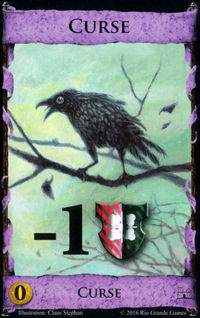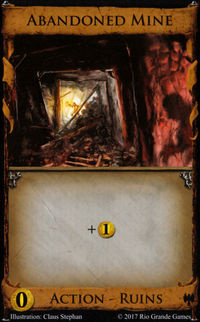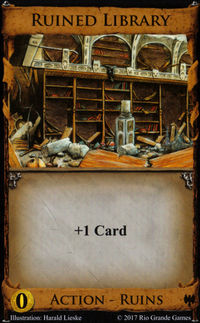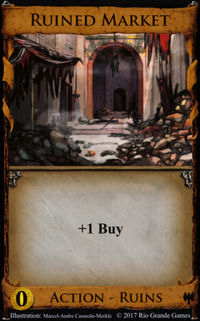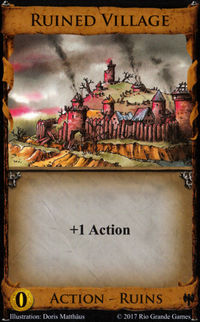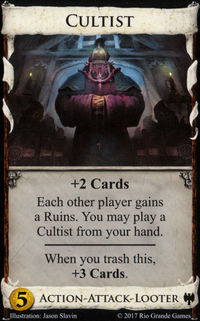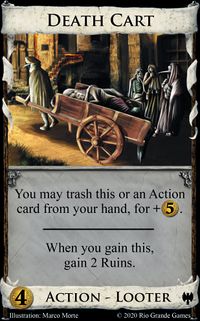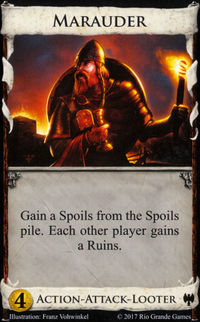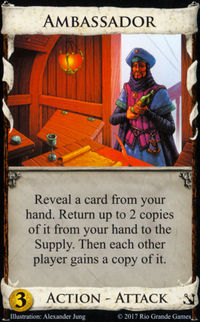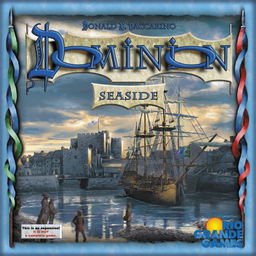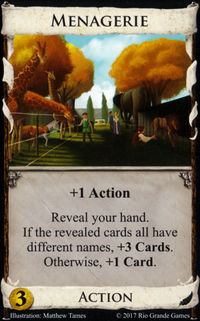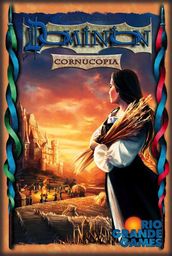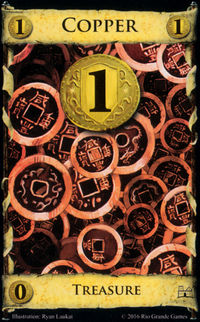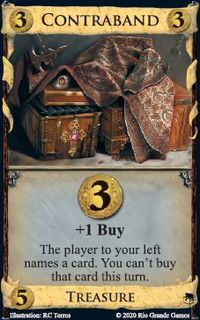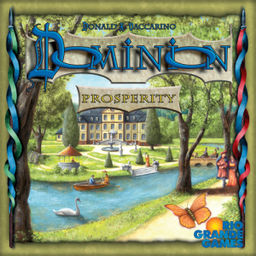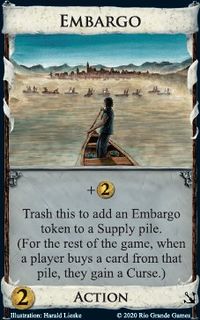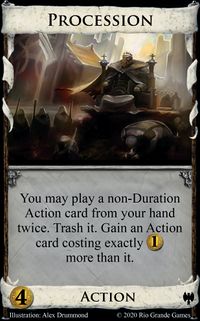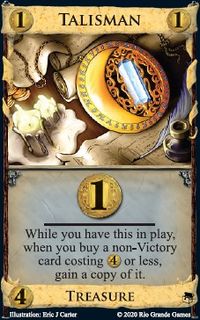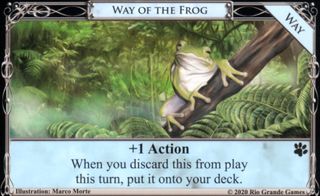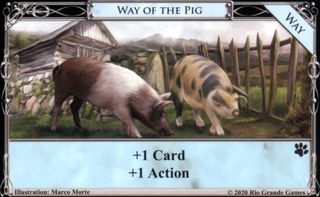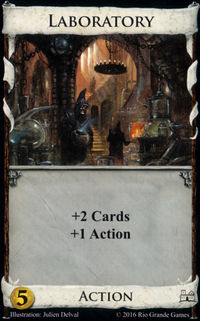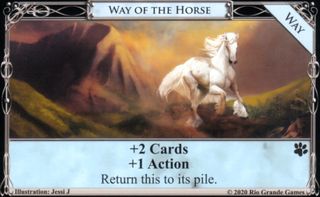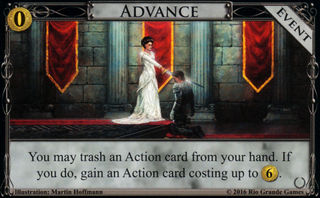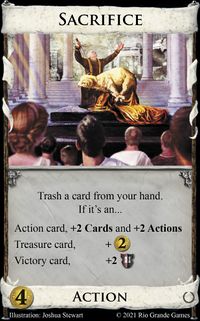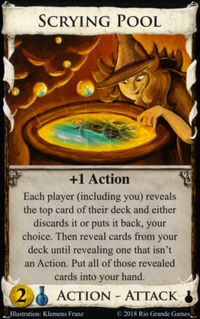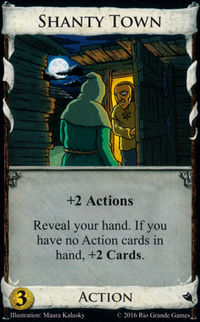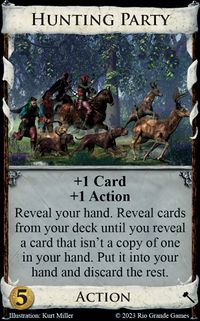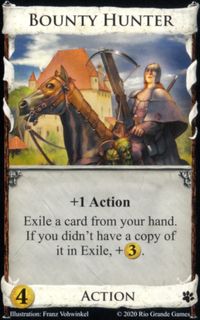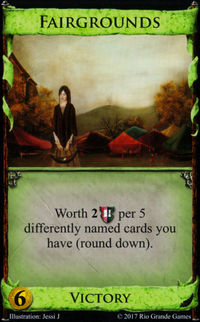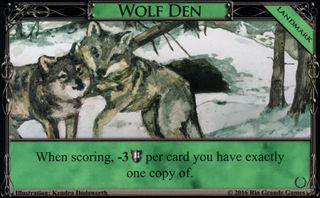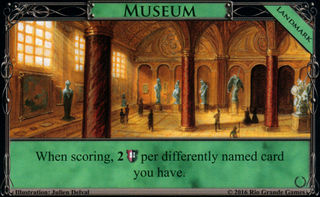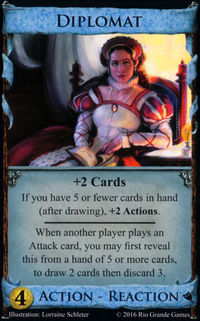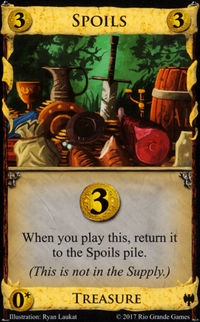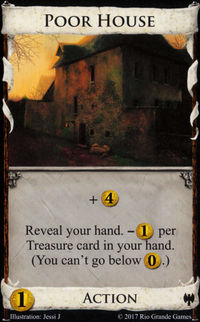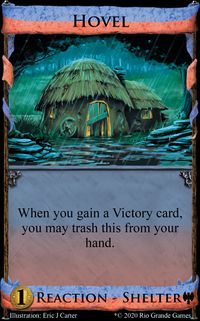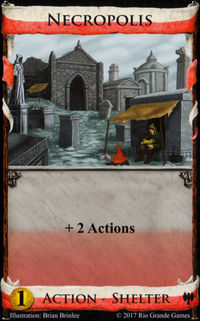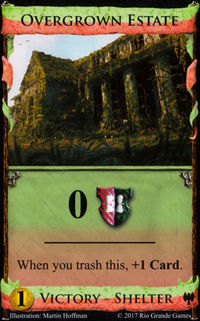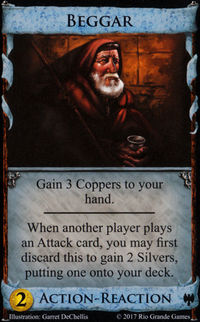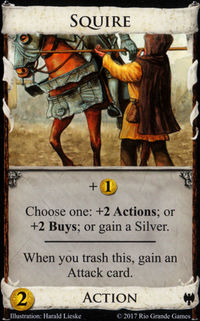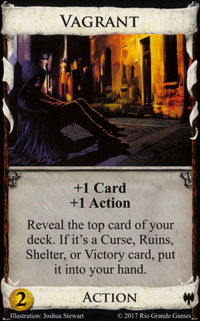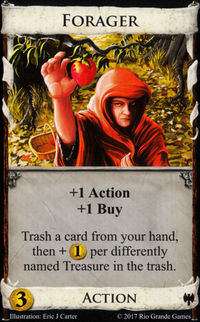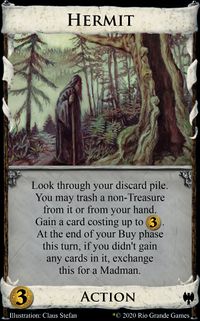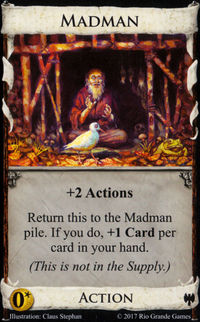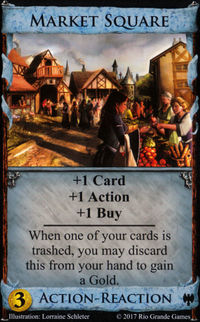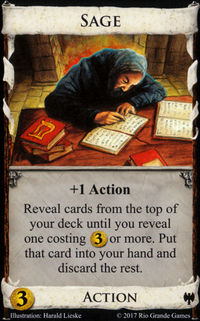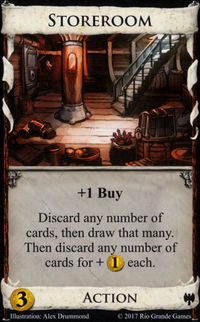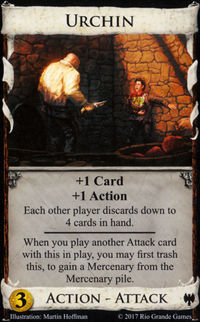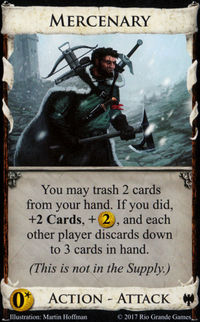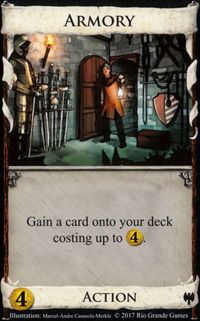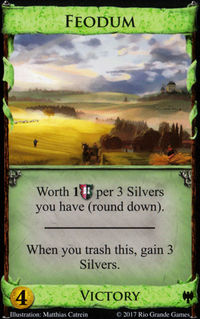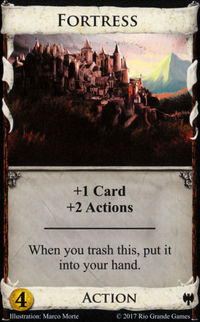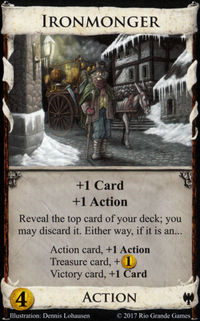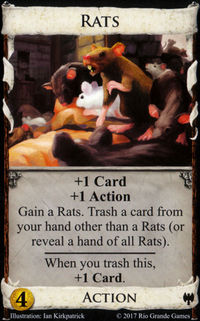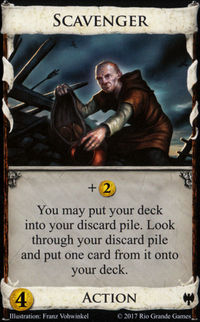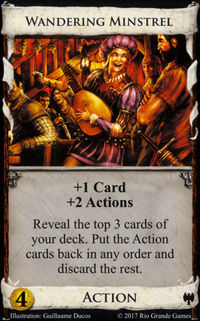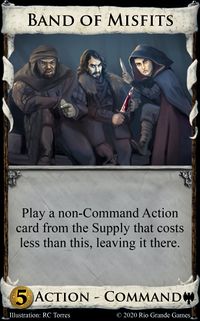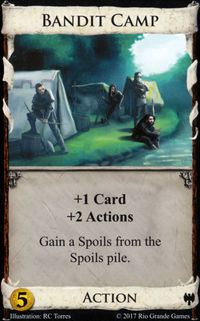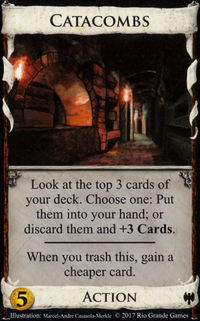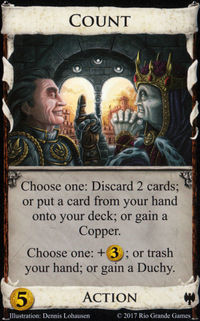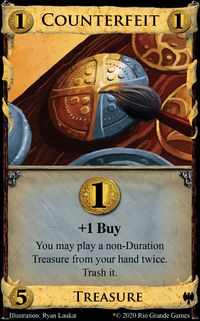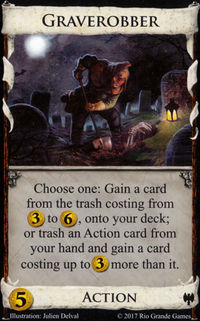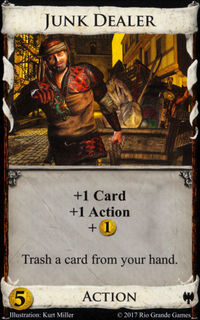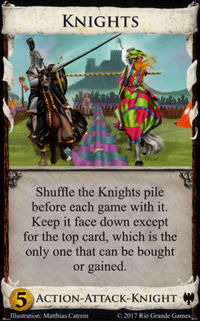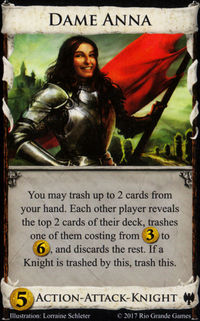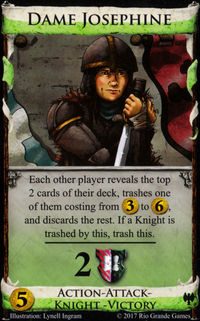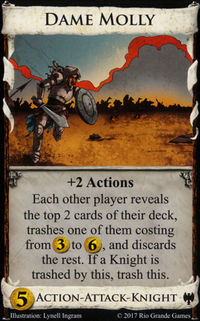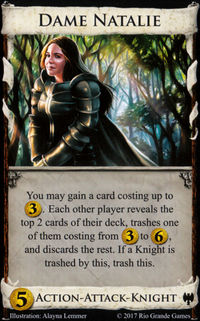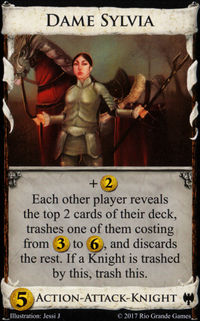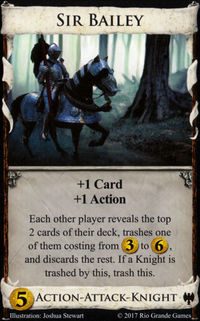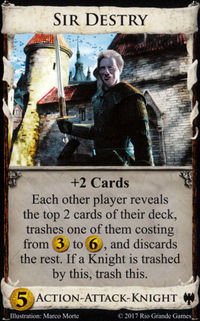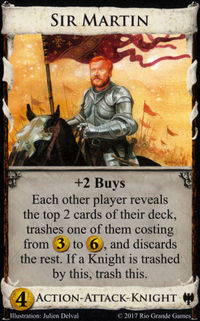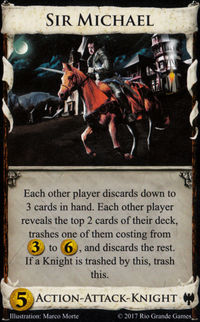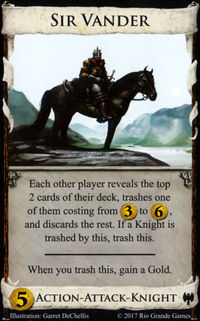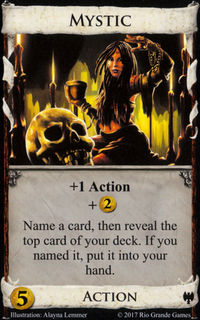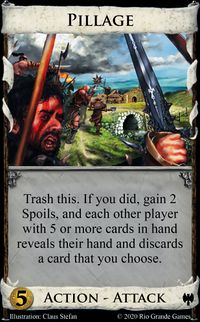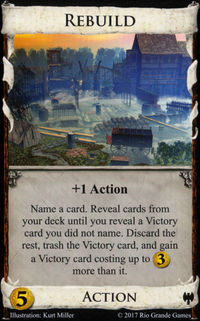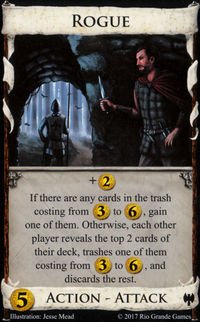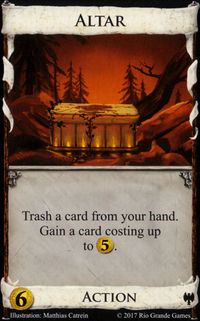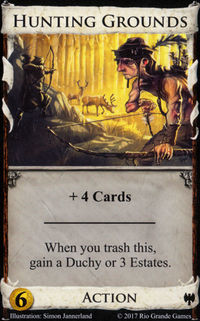Ruins
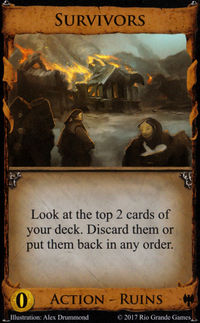
Ruins are a type of basic card in Dark Ages. They are weak and undesirable Action cards costing that are typically added to a player's deck as a penalty or attack (though the player is free to buy or gain them by other means if they want). Ruins are added to the Supply whenever a Looter is present in the game. The supply starts with the same number of Ruins as Curses.
There are 10 copies of each of 5 differently named Ruins cards; however, in games of fewer than 6 players not all 50 will be used. In these cases a random subset of the 50 Ruins are chosen face-down, so players are not aware of the exact contents of the Ruins supply pile. In any event, the Ruins supply pile is shuffled, and only the top card at any given time is face-up and available to be gained or bought.
Four out of five Ruins are cards that give a simple vanilla +1 bonus; these four are named after cards from the base Dominion set that have related effects, and their artwork is based on those or other earlier cards.
Contents |
List of Ruins
The different ruins cards are:
Additional Rules
The rules for playing with Ruins are described in the Dominion: Dark Ages rulebook. The points specific to Ruins are reproduced here.
Preparation
- If any Kingdom card has the type Looter (Cultist, Death Cart, and Marauder have this type), then the Ruins pile is used this game.
- Shuffle the Ruins cards, then count out 10 per player after the first: 10 for two players, 20 for three players, 30 for four players, 40 for five players, or 50 for six players.
- Put the pile face down with the top card face up.
- The remaining Ruins are not used this game.
Ruins pile
- The only card that may be bought or gained or chosen from [the Ruins pile] is the card on top.
- Players cannot look through the [pile], only at the top card; the players turn the top card over any time it is face down.
- If a [Ruins] is returned to [the Ruins pile] with Ambassador (from Seaside), the returned card goes on top.
- Ruins cards with different names […] count as differently named cards for cards that care about this. For example, if Menagerie (from Cornucopia) reveals a hand of Copper, Ruined Market, and Ruined Library, then it will give +3 Cards.
- When Contraband (from Prosperity) is played, a player can name a [Ruins], but that only stops that specific [Ruins] from being bought. However an Embargo token (from Seaside) placed on [the Ruins pile] will affect any cards bought from it.
- Players can buy Ruins even though they normally will not wish to.
- Ruins cards are Actions; they may be played in the Action phase, and count as Actions for things that refer to Action cards, such as Procession.
- The Ruins pile, when used, is in the Supply, and if it is empty that counts towards the normal end condition.
- Cards that try to get specific cards from the Supply fail to get a [Ruins] if the correct one is not the top one. For example, if you buy a Ruined Market with Talisman (from Prosperity), you only gain another Ruined Market if that is the top Ruins under the one you bought; if you use Ambassador (from Seaside) to return [Survivors] to the Supply, the next player will gain that [Survivors], but the player after that will not gain a card, [unless the next Ruins is also a Survivors].
Strategy
Ruins are a type of junk, in the form of Action cards that are so weak you would prefer not to have them in your deck. While they are slightly less harmful than Curses because they carry no ![]() penalty and can occasionally be put to some use, they hinder deck control in the same way, and thus share the most significant downside. Occasionally, you can extract some marginal benefit from playing a Ruin; more importantly, there are sometimes Kingdoms in which the fact that they are cheap Action cards can turn them into neutral or even desirable cards rather than junk. Like Curses, Ruins are commonly a factor in three-pile endings, as they only cost a Buy and can be distributed by Looters.
penalty and can occasionally be put to some use, they hinder deck control in the same way, and thus share the most significant downside. Occasionally, you can extract some marginal benefit from playing a Ruin; more importantly, there are sometimes Kingdoms in which the fact that they are cheap Action cards can turn them into neutral or even desirable cards rather than junk. Like Curses, Ruins are commonly a factor in three-pile endings, as they only cost a Buy and can be distributed by Looters.
Certain Action card-specific interactions transform the nature of the entire Ruins pile, making Looters much less powerful as Attacks and occasionally making Ruins actively worth gaining. The most important of these are with Ways; these vary, as the weakest (e.g., Way of the Frog) offer little improvement, but the most powerful ones can turn Ruins into harmless cantrips (Way of the Pig) or powerful one-shot Laboratories (Way of the Horse). There are also several trash-for-benefit effects that may make Ruins desirable cards for your deck if the opportunity cost of gaining them is low; these include Advance and Sacrifice.
A few other interactions differentiate the harmfulness of Ruins relative to other junk. For example, they don’t disrupt your ability to draw with Scrying Pool, which can draw them, but do affect Shanty Town, which won’t draw cards if you have a Ruin in hand. The fact that Ruins are often differently named also has a few repercussions: it causes Hunting Party to draw more junk cards than it otherwise would, allows Bounty Hunter to generate more frequently when thinning, and may be significantly impactful in terms of ![]() if Fairgrounds, Wolf Den, or Museum is present.
if Fairgrounds, Wolf Den, or Museum is present.
In the absence of significant interactions that affect the whole Ruins pile, you may be able to get some benefit from playing them, although you would usually prefer not to have them in your deck to begin with.
- Ruined Market can be worth playing if you can make use of the extra Buy. Occasionally, it is the only source of +Buy in the Kingdom; given an otherwise sufficiently powerful engine, it may be worth gaining deliberately if it's on top of the Ruins pile, or more rarely even fishing for a copy by distributing or gaining the other Ruins. This makes Ruined Market the most strategically relevant of the five cards.
- Ruined Library is not a stop card, so if you have the spare terminal space, you can at least replace it in your hand with a card that is likely to be more useful.
- Abandoned Mine provides an extra if you happen to have the terminal space to play it.
- Ruined Village non-terminally removes a card from your hand, which might be usable with draw-to-X or for activating certain similar cards such as Diplomat.
- Survivors offers a sifting effect that, while weak and inflexible, can be better than nothing, especially if you know you can clear two junk cards off the top of your deck.
Card gallery
Trivia
In other languages
- Czech: Ruina (sg.)
- Dutch: Ruïne (sg.)
- Finnish: Raunio (sg.)
- French: Ruines
- German: Ruine (sg.)
- Japanese: 廃墟 (pron. haikyo)
- Russian: Руины (pron. ruiny)
- Spanish: Ruinas
Preview
Secret History
Retrospective
